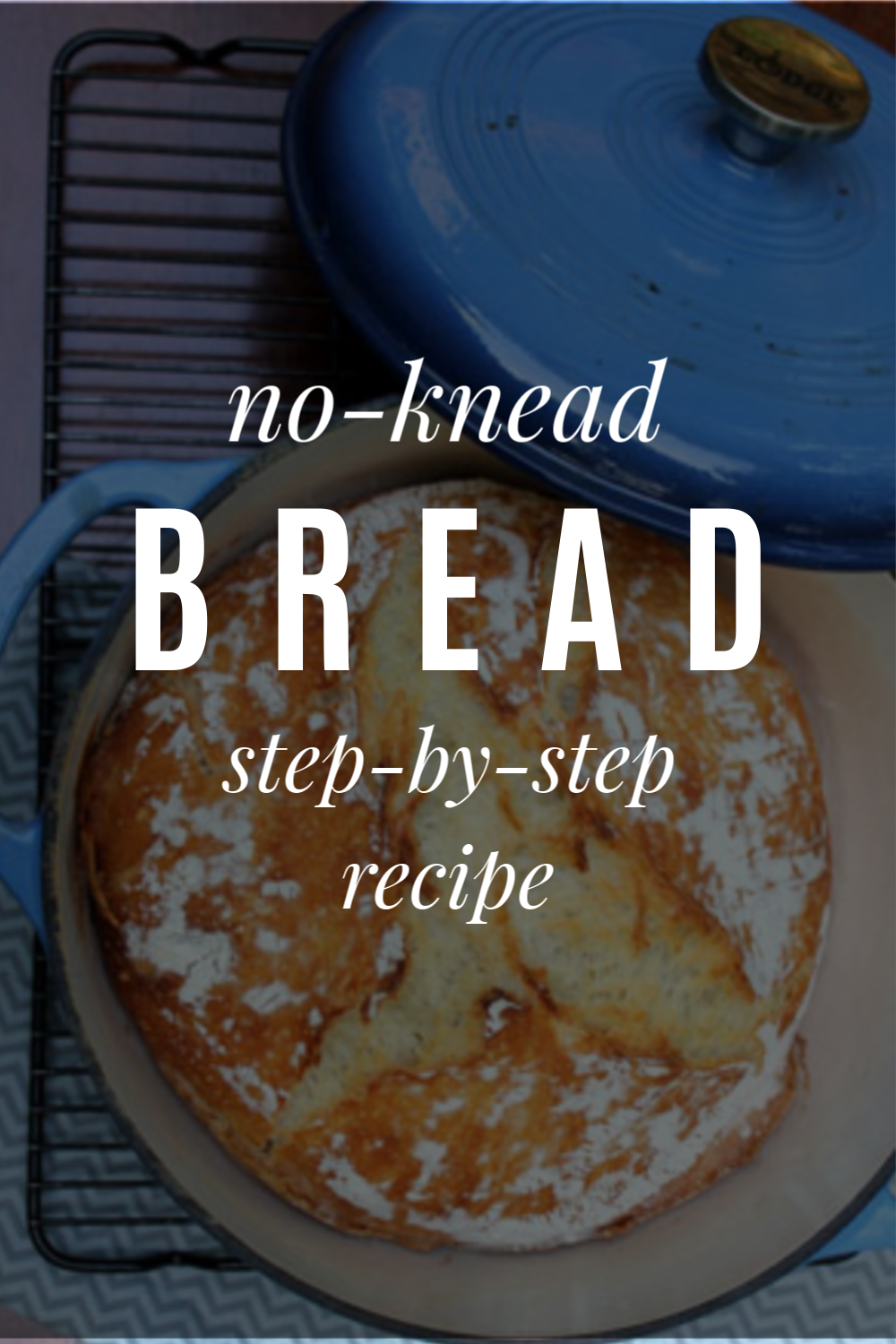
No-Knead Bread Recipe
If you have been hanging out around Frugal Living NW for awhile, you know that I am a big believer in making food from scratch at home. With a few exceptions, I prefer creating something in my own kitchen to buying it in the grocery store.
Bread can be tricky, though. There is some stiff competition out there, and it is tough to replicate a commercial oven’s heat and steam in a normal home kitchen.
For the last several years, I thought that Artisan Bread in 5 Minutes was the best thing since, well, sliced bread. It was simple, and we were content with the results. That is, until last summer when our neighbor brought over a beautiful, delicious loaf of home-baked bread. We had to know her secret. One phone call, and she came back with the book, My Bread by Jim Lahey (Amazon).
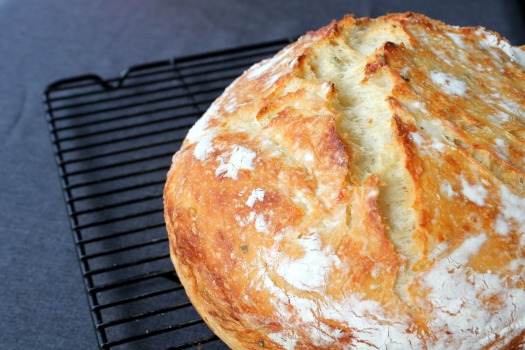
We have been baking bread using this method ever since. I can count on one hand the number of times I have bought bread in the store since then, because I can now make an artisan-quality loaf at home for a fraction of the cost.
I am telling you, this is consistently the best bread I have ever made in my kitchen. Okay, enough gushing. Let’s make some bread.
The only changes I have made to Lahey’s method is to double the amounts and adjust the baking time and temperature to achieve a bigger loaf with a thinner crust.
Oh, and don’t be put off by all these steps. This is totally possible for home bakers at any skill level. I wanted to give you the confidence to do this on your own. A concise recipe can be found at the bottom of this post.
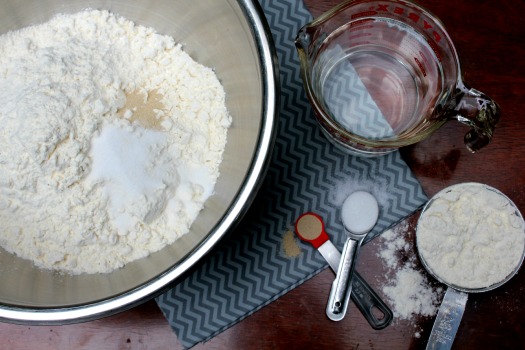
The ingredients are simple: flour, water, salt, and yeast. My husband calculated this bread costs 74¢ per loaf (using Bob’s Red Mill flour & Costco yeast).
Oh, wait! Don’t forget to factor in the roughly 8 cents of energy used to bake it for an hour. No, I’m serious. My husband really does think about this stuff! He’s funny.
So, there you go. A whopping 81¢ for a substantial 2.5 pound loaf of bread. That is crazy cheap.
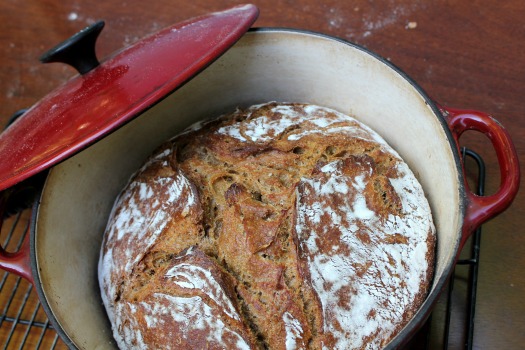
If you want to use some whole wheat flour, substitute 3 cups of whole wheat for 3 cups of the all-purpose flour (3 cups whole wheat and 3 cups of unbleached flour for a total of 6 cups) and add 3 Tablespoons of molasses (optional). This will produce a slightly sweeter, denser loaf of bread. Delicious.
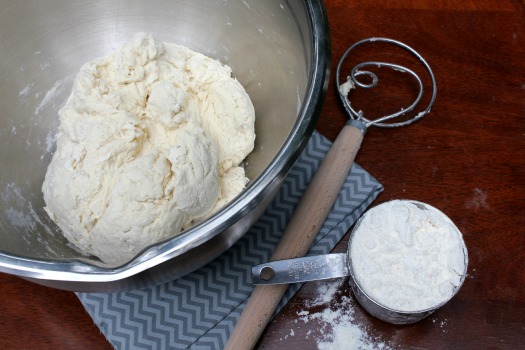
Combine the dry ingredients, add the water, and stir to combine (the funky looking wood-handled item is the amazing Danish Dough Wisk — makes stirring stiff dough a snap). The dough should be wet and sticky. Depending on the temperature and humidity in your home, you may need to add a little more flour or water, 1 Tablespoon at a time. So far, these steps are exactly the same as the 5 Minute method.
The main differences are that you use significantly less yeast (1/2 teaspoon vs. 1 1/2 Tablespoons) and significantly more initial rise time (12-18 hours vs. 2 hours).
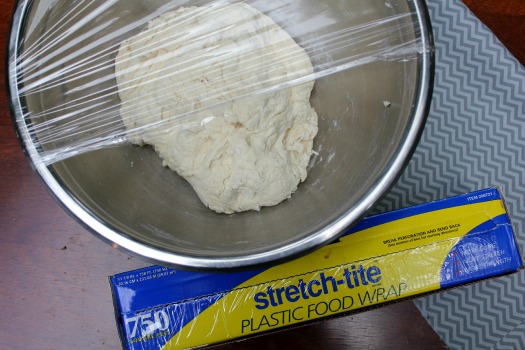
Once the ingredients are completely combined, cover the bowl with plastic wrap and leave it on the counter to rise for 12-18 hours. This slow rise aids in the fermentation of the yeast, giving the bread a better flavor.
Okay, I know what some of you are thinking: 12-18 hours! That’s ridiculous! Who has that kind of time?! I get it.
However, here are two things to consider:
- Once you get into a rhythm of baking your own bread, it’s not a big deal. I start mine in the afternoon or evening and bake it the next morning or afternoon. This would also be an easy weekend routine.
- Just like the title claims, this bread requires no kneading. It is not fussy, temperamental dough. You can produce a delicious loaf of bread with very little hands-on effort & experience.
You’ll know your dough is ready when it has risen in the bowl, smells yeasty, darkened slightly, and is covered with small bubbles.
Using well floured hands, shape and tuck the sticky dough into a rough ball. You can also fold it over a couple times on a well-floured surface. It doesn’t have to be perfect; just keep quickly tucking the dough underneath with your fingertips until you have a semi-smooth dough ball. The dough should be wet but manageable; you don’t want a wet blob so sticky that you can’t shape it into a ball.
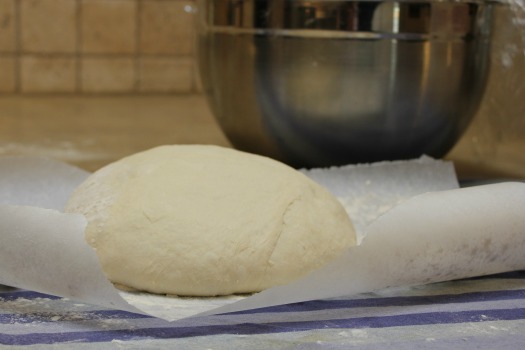
Take a clean linen or cotton tea towel (not terry cloth) and dust it with flour, cornmeal, or wheat germ to prevent the dough from sticking to the towel as it rises. You can also use a floured square of parchment paper on the towel to make the dough ball easier to handle. Place the dough ball, seam side down, in the middle and dust with more flour.
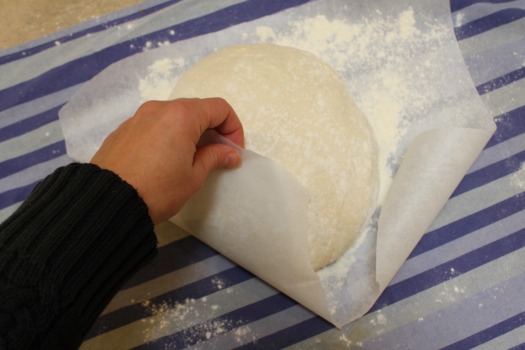
Cover the dough with the (parchment paper and) towel and let it rise for 1-2 hours at room temperature, until doubled in size. During the last 30 minutes of rise time, place a heavy lidded 6-8 quart pot, like a Dutch oven, in a cold oven and preheat it to 425 degrees.
Confession: I own three Dutch Ovens. I use them all the time. They are incredibly versatile and worth the investment. If you don’t own one, you could also make this in any lidded pot, provided it is oven-safe at such high temperatures. Also, check the knob on your pot. If it isn’t rated for such high heat, you’ll want to remove it or cover it with foil. You can also buy an inexpensive replacement knob that is rated for higher temps!
Okay, this is the trickiest part of the entire operation. Remove the lid from the piping hot Dutch Oven, slide your hand underneath the towel or parchment paper, and flip the risen dough (seam side up now) into the pot. Try to flip close to the pot or the flour will fly everywhere. Remove the towel or paper and set aside.
This might take a bit of practice, but again it doesn’t have to be perfect. Some of my worst flips have produced my most beautiful loaves. I love what Lahey writes, “…even the loaves that aren’t what you’d regard as perfect are way better than fine.”
Place the lid back on top and slide the pot back into the hot oven.
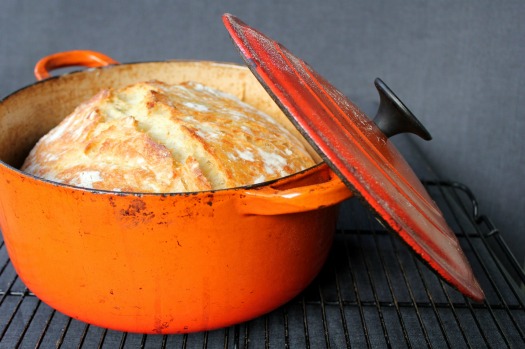
Bake it for 40-50 minutes. Remove the lid. Bake for another 5-10 minutes, until golden chestnut brown. The internal temperature should be around 200 degrees. You can check this with a meat thermometer if you’re nervous about knowing when your loaf is done.
Oh man, your house will smell so good about right now.
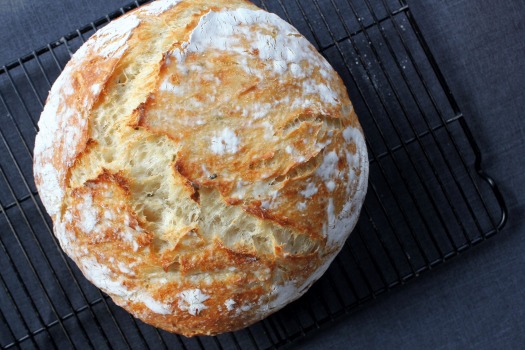
Place the loaf on a cooling rack. You will hear it crackling as it cools. Use every ounce of self-control to resist cutting into it until it is “quiet”; cutting it too soon will make the bread dense and gummy.
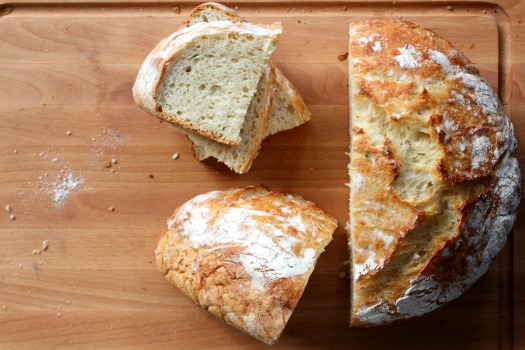
This bread is best the first 2-3 days. I just store my leftover loaf inside the Dutch oven on the countertop. Using plastic wrap will soften the crust. Dry, leftover bread makes great bread crumbs, toast, French toast, or croutons!
Enjoy. And pat yourself on the back. You just baked an amazing loaf of bread!
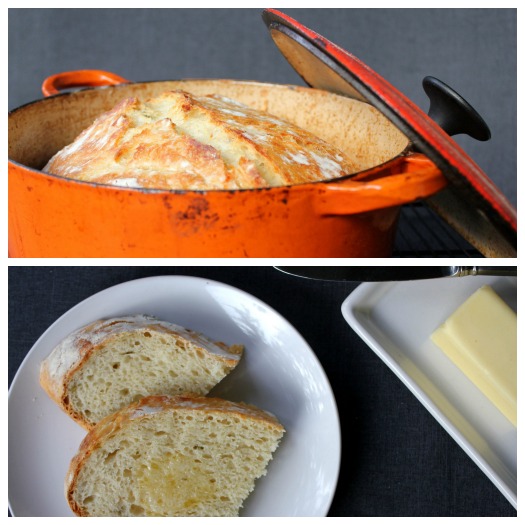
Basic No-Knead Bread
Slightly adapted from Jim Lahey’s My Bread
Ingredients
6 cups bread flour (recommended) or all-purpose flour, plus more for work surface
1/2 t. instant or active-dry yeast
2 1/2 t. salt
2 2/3 c. cool water
- In a large bowl, combine the flour, yeast, and salt. Add the water and stir until all the ingredients are well incorporated; the dough should be wet and sticky. Cover the bowl with plastic wrap. Let the dough rest 12-18 hours on the counter at room temperature. When surface of the risen dough has darkened slightly, smells yeasty, and is dotted with bubbles, it is ready.
- Lightly flour your hands and a work surface. Place dough on work surface and sprinkle with more flour. Fold the dough over on itself once or twice and, using floured fingers, tuck the dough underneath to form a rough ball.
- Place a full sheet/large rectangle of parchment paper on a cotton towel and dust it with enough flour, cornmeal, or wheat bran to prevent the dough from sticking to the parchment paper as it rises; place dough seam side down on the parchment paper and dust with more flour, cornmeal, or wheat bran. Pull the corners of parchment paper around the loaf, wrapping it completely. Do the same with the towel. Let rise for about 2 hours, until it has doubled in size.
- After about 1 1/2 hours, preheat oven to 425 degrees. Place a 6-8 quart heavy covered pot, such as a cast-iron Dutch oven, in the oven as it heats. When the dough has fully risen, carefully remove pot from oven. Unwrap the towel and parchment paper from around the dough and slide your hand under the bottom of the dough ball; flip the dough over into pot, seam side up. Pull the parchment paper off, scraping any stuck dough into the pan. Shake pan once or twice if dough looks unevenly distributed; it will straighten out as it bakes.
- Cover and bake for 40 minutes. Uncover and continue baking for 10-15 more minutes, until the crust is a deep chestnut brown. The internal temperature of the bread should be around 200 degrees. You can check this with a meat thermometer, if desired.
- Remove the bread from the pot and let it cool completely on a wire rack before slicing.
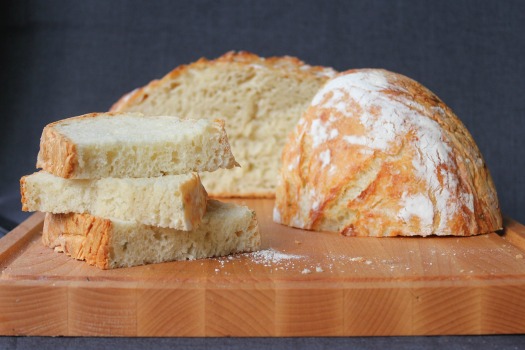
Here are a couple options for Dutch Ovens. Any heavy, lidded 5-8 quart pot (seasoned cast iron or enamel coated) would work with this recipe. Lodge has the best prices/options for dutch ovens on Amazon.
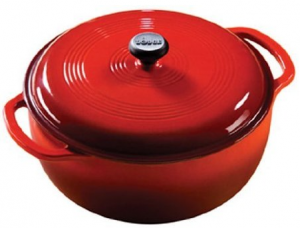
Lodge Logic Dutch Oven in Island Spice Red (6 Quart)
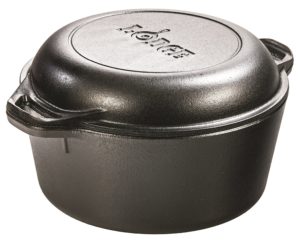
Lodge Cast Iron Double Dutch Oven (5 Quart)
If you already have a dutch oven (or find a deal on a lesser-known brand) that doesn’t have a knob rated for high temps, replace it! There are some really affordable options.
Got questions? You are in good company. Go here for the complete FAQ list.
Looking for more variations to the no-knead bread recipe? We’ve created a list with sweet and savory varieties, including the following:
- Cranberry Orange
- Four Cheese
- Sandwich Bread
- Dark Chocolate Coconut
- Tomato Basil Cheese
- Whole Wheat
Looking for more delicious bread recipes?
Find more delicious recipes on our Recipe Page!
Follow Frugal Living NW on Pinterest!
Fantastic range of boards from best recipes and tips for frugal living to gardening and budgeting help.
This post may contain affiliate links. See the disclosure policy for more information.
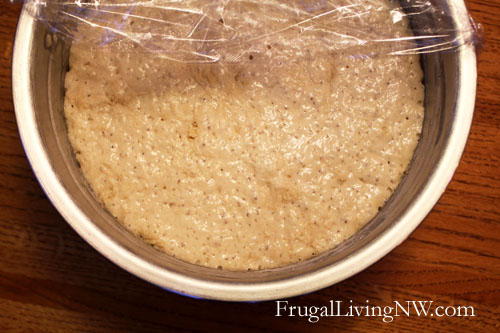
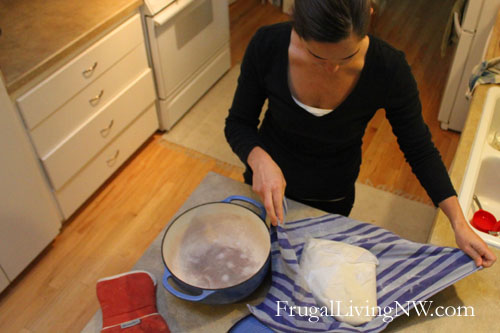
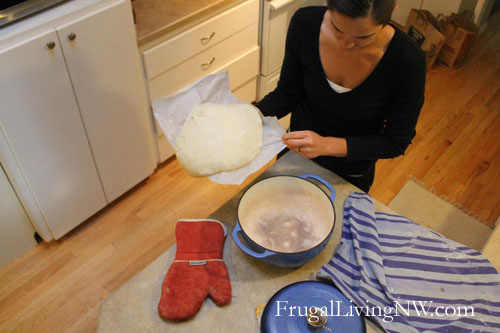

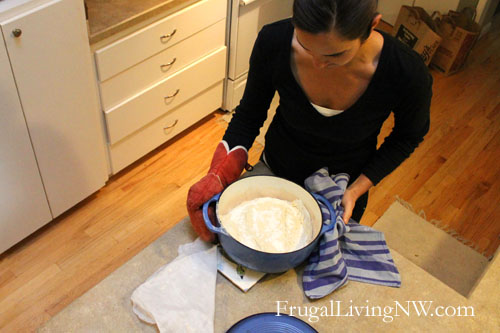


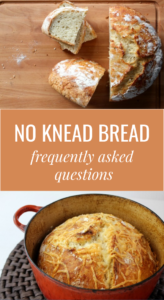
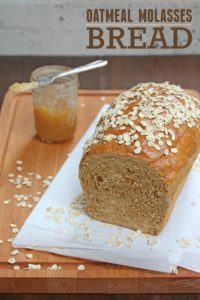
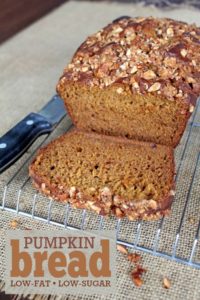
Holy crap, it worked! Brilliant post!
i really like this recipe and would like to use it with some slight tweaks on my website on a beginners bread tutorial. you will be credited and a link to this page will be left below
I’ve been making this bread for many years to take to potlucks, and I’ve tried to explain these tips before, but didn’t get much response, so I’ll try again. I did some experimenting, and here’s what I found: Blend 2 cups of AP bread flour with 1 cup of whole wheat flour*. Then blend in 2 tsp. Garlic Salt (optional, but gives a nice flavor), and ¼ tsp. Fast Acting Yeast. Then stir in 1 ¾ cups luke warm water (to help activate the yeast). (You must thoroughly blend all flour into the moist dough because it will leave pockets of flour in the finished bread if you don’t.)
*You could also use just three cups of AP flour with no wheat flour at all.
I then cover the bowl with a clean motel shower cap, and let it rise overnight (8 to 24 hours is about right). The rise doesn’t seem to be at all critical, although I’ve never let it rise for longer than about 24 hours. NOTE THAT I SAID NOTHING ABOUT A SECOND RISE! YOU DON’T NEED IT! Yes, I’ve tried both ways and, trust me—YOU DON’T NEED A SECOND RISE. (So now the bread is much easier then you thought.) The level of rise depends on your room temp. etc. but I’ve always found that the bread will rise to about the same size in the oven even if it wasn’t very big just before baking.
Loosen and coat the wet dough by sprinkling a generous amount of flour around the inside edge of the bowl and working a rubber or silicone spatula between the bowl and the dough all around to distribute the flour and make the dough look more like it had been kneaded. Then bake at 450 degrees by heating the pot and lid in the oven (LID OFF WHILE HEATING), then VERY CAREFULLY dumping or rolling the loose dough from the bowl into the hot pot. Cover and let it bake for about 25 minutes—then another five minutes with the lid off to brown the top. (The non-stick properties are achieved by instantly baking the layer of dough that first hits the hot pot.) NO GREASE, BUTTER, ETC. IN POT (it would just burn and smoke in the high heat).
I then let it cool slightly, and eat some of it warm. I slice my loaf in half then freeze half for later. I lay the remaining half cut side down on the board and make slices from only one half of the loaf instead of making unwieldy slices from the entire loaf.
So that’s all there is to it. And pardon me if this applies to you, but don’t ask dumb questions. Try it and see what happens if you do this or that, or eliminate this or that–then you’re the expert and can share what you learned with the rest of us.
I forgot to mention that I heat my oven to 450, not 425.
Thanks Dave, I really appreciate your tips and explanations.
My bread doesn’t seem to rise very much and does not have large air pockets when cut. I use bread flour and whole wheat 2:1. My second rise is often non existent. Any ideas to improve rise? More water? more yeast?
Maybe let it rise in a slightly warmer place? And be sure to use fresh yeast and not too warm water so as to avoid killing the yeast.
Hi there! This recipe is fantastic. Have you ever refrigerated the dough to use for a later time at the time of shaping? I was thinking about shaping the loaf and then putting it in the refrigerator to rise and bake later?
I’ve never tried storing the dough either in the fridge or freezer. But, as I mentioned, try it and see what happens–then share what you learned.
Have you ever frozen a loaf? I know that sounds crazy to freeze fresh bread – but it seems like it would be nice to have a loaf on hand for when I can’t get to making it! Or maybe freeze the dough???
HiDeb,
I always make two of the six cup loaves, cut each one in half and freeze. I take out half at a time and enjoy. The bread is delicious after thawing and I do this so I bake far less often and it’s so good my daughter now does it too.
I slice the loaf into about 1” thick pieces which I cut half and freeze.
Thaw and put in toaster oven.
I made this into 2 smaller loaves… so easy. I thought it had stuck to the bottom of my dish at first but it did come away unscathed eventually. My neighbor came in a few minutes after turning out and mmmm’d and ahhh’d appropriately. I don’t see where I can post a photo!
Oh, I don’t have a Dutch oven. 1 loaf I put directly into container to rise then in oven the other I tipped into the hot dish…. both seem the same.
I read that some people didn’t warm up the dutch oven. Has anyone tried letting it rise directly in it for the second rise instead of using parchment?
I make this bread quite often, and I start it the evening before baking day, and let it bubble away on the counter for close to 24 hours. I preheat my oven and pot, and scrape the dough directly into the hot pot. I don’t do a second rise at all. Straight into the oven for the bake. I know, I will get comments about this, but I have been making bread for over 30 years, and just with this recipe, this works great for me. I have also found that if I alter the recipe, for example, beer for part of the water, or add a sweetener or olives, whatever, that I have better results if I scrape the dough onto parchment and then put parchment and all into the dutch oven. I have had some problems with the loaf sticking in the pot with the add-ins without the parchment.
I love this recipe. However, I’ve been having difficulty getting my dough to rise during the cooler months. Any advice??
Turn your heat up.
I, too, often make bread in a Dutch oven. However, I have adopted/adapted the “Cook’s Illustrated” method for getting the dough into the ¡HOT! pot: Place the unrisen dough in the center of a rectangle of parchment paper that is as long as the diameter of the pot, plus a bit more than twice as deep as the pot. Width is relatively unimportant, though you can trim the width of the parchment to match the pot’s diameter. I usually then cover the dough with a LARGE bowl to rise. When the dough is risen and oven preheated, I use the strip of parchment like a sling to lift the dough into the Dutch oven. There’s far less risk of dropping the dough, missing the pot, or scorching one’s hands.
The parchment will probably scorch and become too brittle to lift the finished loaf out of the pot, but one hopes that the bread is less collapsible than it had been previously..
Have you ever made half this recipe? I am making bread for some neighbors and I’d like to give them a smaller loaf. Any suggestions?
Love this recipe!
MLI
I haven’t cut the recipe, but I have split one. I divided the dough in two after the final proof and baked them in smaller containers (Corningware with lids) and once I divided the dough into 8 balls and baked them in stoneware bowls, uncovered. Successful both ways.
Great! Thanks so much!
I make half all the time – cook it in a covered Pyrex casserole, cut the temp down to 390-400 and use an instant read thermometer after 20 minutes or so. Looking for 190-200 internal temp. Always turns out great.
So, bread looks delicious… but I can’t get it out of the pot? Did I miss a step in oiling it or something?
I oiled my container.
I made this today. .. yum! Chewy and crusty. It didn’t really bubble up like your picture but it still worked fine.
How many calories approximately are in a slice of this bread?
Mahalo for this great recipe! I love it and really appreciate you sharing it with us!
Can you use “self-rising” flour for this recipe and omit the salt & yeast?
Your instructions didn’t say to oil the pan. Just came out of the oven and it is stuck to the pan! Not sure what to do.
Love this method. I don’t flip the dough into my dutch oven, I place the whole parchment paper in with the seam side down and it comes out perfect every time. I also use whey in place of water from my homemade yogurt to give it a sourdough flavor. I ‘ve done many variations to this bread and never disappointed. Very forgiving.
In the measurement column, does the t stand for teaspoon or tablespoon?
t = teaspoon
T = tablespoon
I’ve used this amazing recipe countless times to amazing results. I’ve just received some sourdough started and am curious if anyone has tried this recipe using starter. Does anyone know the ingredient ratios with starter instead of yeast?
Jennifer I’d like to know the answer to your question. Did you get any response and if so can you share please?
Thanks
It’s delicious! But I couldn’t get it out of the pot! The sides pulled away easily, but the bottom wasn’t going to have it. So I left the bottom crust and some of the fluffy bread on the bottom of the pan and scraped it off. I just read in another comment that they cooked it in the parchment paper after the second rise. I will definitely do that next time! I don’t know why I thought it would be easy to come out since there is no fat anywhere to be found!
I’ve been making this for years, one in a crummy cast iron Dutch oven, one in a Le cruset and neither have ever stuck. I always make two at a time, cut in half when coool, freeze in giant zip lock and take half out at a time. Also, I never use plastic wrap when loafs rise. I cover one with a frying pan cover and one with a large plastics Tupperware cover. Neither fit tight. I also make one whole wheat and molasses version and one plain white.
Yvette would you be willing to share your Whole wheat and molasses recipe?
What size dutch oven? New to this type of bread baking… Love my bread machine but…….
My 14 yr old son was just asking me a few days ago if he could try baking a loaf of bread and when I saw this post I knew it was perfect for his first try! It is in the pantry for the long rise— Can wait to try the finished product tomorrow. We’ll let you know how it turns out
We have made this several times now and it comes out lovely every time! I bake it in the parchment paper and I don’t heat the dutch oven first. I’ve made in both a 5 qt and an 8 qt.
WOW, Just made this boule and it is absolutely wonderful. I was cursing when I was trying to pull the dough away from the parchment paper after the second rise but after some yanking I was able to get it into the hot Dutch oven. It baked up to be 10 inches high, crusty and chewy on the inside. This will be my dinner party bread from now on!!!!! THANK YOU SO MUCH
I have just made your wonderful loaf! Possibly the easiest and best bread I have ever made and I’ve probably tried every bread-making method in existence! Thank you so much. I shall be passing the recipe on to my friends as well as boasting a fabulous photo of said loaf on FB. I live in Devon, SW England, and good bread is hard to find or ridiculously expensive. Much of our commercially produced bread is made by the “Chorley Wood Method ” where the rising stage is speeded up by the use of Vitamin C. The resulting bread is flabby and tasteless. Hurrah for the No-Knead Loaf!
Can you give me, please, the amount for the flour and water in oz? I live in Spain and we use grams, kilo etc, but it would be easier to convert from oz than from cups.
Just made this for the first time today. Followed some advice: left bread on parchment after second rising and placed in pot and sprinkled some water on the top crust. BEST BREAD I HAVE EVER MADE! Thank you for the recipe!
Does anyone have the calorie count on this?
Any chance you could provide the original recipe, for those of us who want a smaller loaf, a shorter bake time, and a thicker crust?
I used to make this bread with great success when I was near sea level. Has anyone tried it at higher altitudes? Any adjustments for ~5000 ft?
It works for me at 7000 feet in Colorado.
I live above 6000 in Utah and this recipe works very well for me. I add 2 tsp. sugar to the recipe too. It’s so easy, smells divine, and tastes great. I keep the parchment under the loaf and drop all of it into the dutch oven – I have the Lodge 6-quart. I have found that a spritz of water on the top of the bread before baking results in a bit softer crust, I like it that way. We empty-nesters cut the loaf in half and refrigerate one half while eating from the other. I took a loaf to my son and daughter-in-law’s home last week and her family loved it too. We made another loaf while there so she could see how easy it is – I think I made another fan!
I tried baking and the results were amazing. On,y thing is it takes a long time but worth the effort.
I didn’t hear the crackling of the crust and find it a bit hard but I was told that if you spray some water on the surface of the dough before baking, it will give the crust a better cracking texture. Thanks for sharing
Has anyone ever tried this using gluten-free flour? Advice?
Jordan, if you head over to Simply So Good (which uses a similar method), she has a large Q&A forum, including notes on GF bread. CTRL+F this term (Star’s recipe for GF bread) when you get to this page: http://www.simplysogood.com/2010/03/crusty-bread.html
Hope that helps~
Do you suppose you could divide it before the second rise and bake it as rolls or bread sticks?
I’m trying your recipe as I make the same type of bread but 1/2 your ingredients. I love the idea of making a double loaf. One suggestion for you – just lower the parchment paper into the dutch oven and let it bake with the bread. This also makes it easy to pull the bread out as you can grab the paper to transfer onto a cooling rack. Then throw the paper away.
Won’t the action of flipping the dough into the pot after the second rise break the dough and result in a flat, dense bread, as all the carbon dioxide that is trap inside the dough will be released? As I experienced before.
I just made some today… oh ,how delicious it is…. crusty and melt in your mouth in the middle. I took a phot but can’t see how to post it.
I’ve made this bread several times and each time the dough has stuck to whatever I used for the second rise time. I’ve tried floured cloths, Saran Wrap, and parchment paper Today I feel like a genius! I put down a square of freezer paper (plastic side up), floured it before putting down the dough, put the dough down, then lightly floured the top and gently covered with a plastic bag you get from the grocery store for fruits and vegetables. When I went to dump the dough into the hot dutch oven, I pulled over the plastic bag (which left no residue and came off easily.). Then I picked up the entire sheet of freezer paper, dough and all, and it fell into the pot like butter! Try it for yourself. I think you’ll be pleasantly amazed.
I just made this loaf and it looks and smells delicious, but there is no way on this earth that it is going to come out of the dutch oven without scratching up my dutch oven or ruining the sides and bottom of the loaf. How do you keep it from plastering itself to the bottom of the dutch oven? It was covered in flour. I know the FAQ page says not to coat the dutch oven with anything, but I’m very tempted to do it anyway.
When I make the bread, I use a SPLASH of olive oil and rub it all over with a paper towel. This helps absorb excess oil but still give the bottom and sides a coat (You really don’t need to over do it at all). Hope that helps!
Drop a large sheet of parchment paper into your dutch oven before putting the wet dough in.
Put the dough on the parchment paper and drop the whole thing in the pot, parchment on the bottom. Works great!
I tried skipping the second rise after making this recipe to the letter dozens of times. Verdict based on looks: wouldn’t recommend it. It came out incredibly flat. I’m worried it’s going to be heavy and dense. After it cools I’ll find out for certain.
Stick to the original method!
This was as easy to do as it was AWESOME to see…and eat. The house smelled great while it baked and the results were…well, spectacular. If I could post a photo I would. The loaf was half gone in less than a minute as everyone ripped off piecesRichard and dipped in olive oil and balsamic vinegar. I broke out the honey and all I had left after 10 minutes were crumbs, complements, and smiles.
Is there any other reason to be in the kitchen?
Thanks for sharing the recipe. Can I use a granate ware roasting pan?
I have even successfully used an ovenproof salad bowl with a cookie sheet on top.
I just made my first loaf. Wow it is so good. I put in dried cranberries and roesemary and let me tell you I make bread and rolls all the time with everyone loving them, but this is the best I have ever made. Thank you so much.
Thank you for your recipe my oven was at 250°c. The crust is beautiful.
my oven was at 250°c. The crust is beautiful.